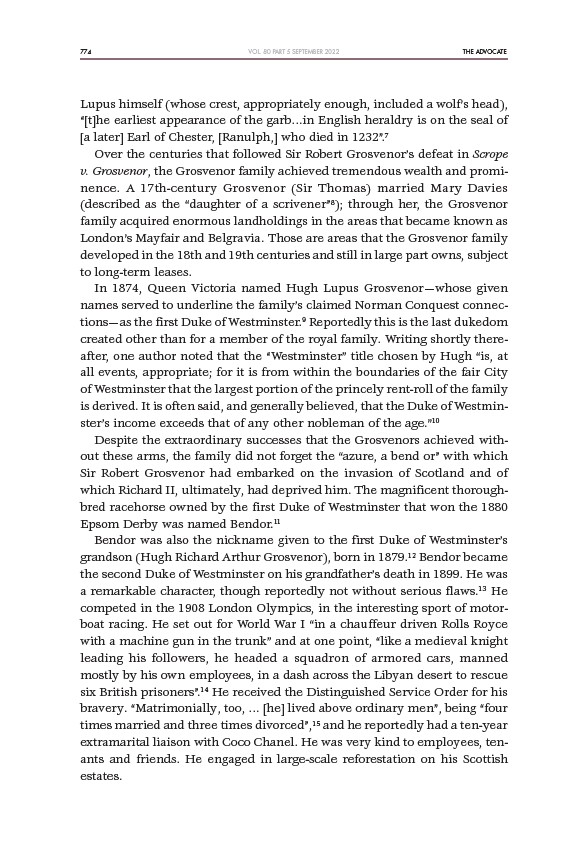
774 THE ADVOCATE
VOL. 80 PART 5 SEPTEMBER 2022
Lupus himself (whose crest, appropriately enough, included a wolf’s head),
“the earliest appearance of the garb…in English heraldry is on the seal of
a later Earl of Chester, Ranulph, who died in 1232”.7
Over the centuries that followed Sir Robert Grosvenor’s defeat in Scrope
v. Grosvenor, the Grosvenor family achieved tremendous wealth and prominence.
A 17th-century Grosvenor (Sir Thomas) married Mary Davies
(described as the “daughter of a scrivener”8); through her, the Grosvenor
family acquired enormous landholdings in the areas that became known as
London’s Mayfair and Belgravia. Those are areas that the Grosvenor family
developed in the 18th and 19th centuries and still in large part owns, subject
to long-term leases.
In 1874, Queen Victoria named Hugh Lupus Grosvenor—whose given
names served to underline the family’s claimed Norman Conquest connections—
as the first Duke of Westminster.9 Reportedly this is the last dukedom
created other than for a member of the royal family. Writing shortly thereafter,
one author noted that the “Westminster” title chosen by Hugh “is, at
all events, appropriate; for it is from within the boundaries of the fair City
of Westminster that the largest portion of the princely rent-roll of the family
is derived. It is often said, and generally believed, that the Duke of Westminster’s
income exceeds that of any other nobleman of the age.”10
Despite the extraordinary successes that the Grosvenors achieved without
these arms, the family did not forget the “azure, a bend or” with which
Sir Robert Grosvenor had embarked on the invasion of Scotland and of
which Richard II, ultimately, had deprived him. The magnificent thoroughbred
racehorse owned by the first Duke of Westminster that won the 1880
Epsom Derby was named Bendor.11
Bendor was also the nickname given to the first Duke of Westminster’s
grandson (Hugh Richard Arthur Grosvenor), born in 1879.12 Bendor became
the second Duke of Westminster on his grandfather’s death in 1899. He was
a remarkable character, though reportedly not without serious flaws.13 He
competed in the 1908 London Olympics, in the interesting sport of motorboat
racing. He set out for World War I “in a chauffeur driven Rolls Royce
with a machine gun in the trunk” and at one point, “like a medieval knight
leading his followers, he headed a squadron of armored cars, manned
mostly by his own employees, in a dash across the Libyan desert to rescue
six British prisoners”.14 He received the Distinguished Service Order for his
bravery. “Matrimonially, too, … he lived above ordinary men”, being “four
times married and three times divorced”,15 and he reportedly had a ten-year
extramarital liaison with Coco Chanel. He was very kind to employees, tenants
and friends. He engaged in large-scale reforestation on his Scottish
estates.